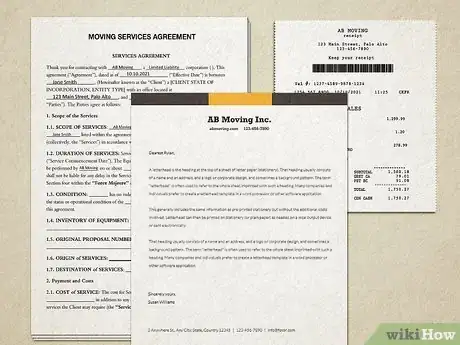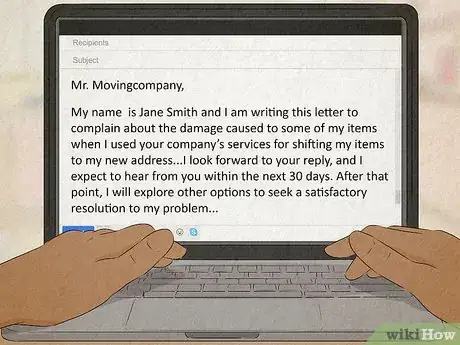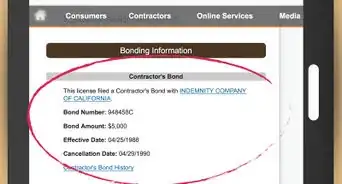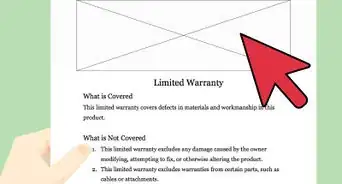This article was co-authored by Clinton M. Sandvick, JD, PhD. Clinton M. Sandvick worked as a civil litigator in California for over 7 years. He received his JD from the University of Wisconsin-Madison in 1998 and his PhD in American History from the University of Oregon in 2013.
wikiHow marks an article as reader-approved once it receives enough positive feedback. In this case, 84% of readers who voted found the article helpful, earning it our reader-approved status.
This article has been viewed 115,267 times.
When you hire a moving company, they take responsibility for ensuring your goods arrive safely and not damaged or broken. But some moving companies can end up damaging your items, accidentally or due to carelessness, and you may decide to file a claim against them to recover the cost of replacing or fixing any damaged items. In order to make a claim against your moving company for damages to your items during the move, you should first collect evidence of the damage so you can use this evidence to support your claim. You will then need to draft the claim and file it within the appropriate time to ensure your claim is processed.
Steps
Gathering Evidence of the Damage
-
1Take pictures of the damage. It’s essential that you document the damage by taking pictures of all of the items that were damaged by the moving company. You should use a good digital camera to take these pictures, being sure to get detailed, in focus images of all the damage on each and every item.[1]
- As well, you should keep all the damaged items in your possession in the event the moving company asks to inspect the items to confirm the damage. If an item is broken, keep all the pieces of the item together in a bag. If an item is damaged and can no longer be used, store it in a garage or spare room so you have it on hand as evidence of the moving company’s negligence.
-
2Document all contact with the moving company. Write down the date and time of every contact you had or still have with the moving company in a notebook. Be specific about the date and time of each conversation with the moving company as you will need to use it as evidence in your claim. Specific dates and times will carry more sway than a more general note, such as “I spoke to them sometime in June” or “We talked a few times in March.”
- You should also document every person’s full name and their contact information, such as their email and phone number. If any persons from the moving company do not provide their full name, ask them for their employee ID number.
Advertisement -
3Save all hard copy documents from the moving company. Hard copy documents, such as emails, contracts, bills, receipts, letters, and faxes, will act as key evidence to support your claim. They can provide a clear timeline of when you hired the moving company, when they moved your items, and when you discovered the items were damaged.[2]
- Before you send any original documents back to the moving company, scan it or copy it so you have a copy for yourself. Use the Delivery Confirmation option on your email to store a copy of your outgoing emails to the moving company.
- You can also use the postal tracking number on your items to get a Proof of Delivery notice via the shipment company used by the moving company. This can then act as proof that the items were delivered to your new residence by the moving company, indicating they are liable for any damage to the items.
-
4Make an inventory of the damaged items and their monetary value. To strengthen your claim, you should examine each damaged item and make an inventory of each item. Then, you should try to determine their monetary value, or how much you paid for each item. This inventory list can then be used as supporting evidence in your claim, and in the event you decide to go to small claims court to sue the moving company for damages.
- It may be difficult to determine the monetary value of the items if they are very old or used. Look for any receipts you may have saved for the damaged items, or think about where you bought the item from originally. If the movers have damaged a one year old television, for example, you may remember that you purchased the television for an electronics store. You can then visit the electronics store’s website and look for the same television or a similar model. Print out the current price listed on their website as proof of the monetary value of the damaged television.
- If you paid for any of the damaged items with your credit card, you can search your credit card statements for a receipt of the item showing how much you paid for it. You could also visit the store where you bought the items in person and ask the salesperson for a new receipt as evidence for your claim.
- You can then create a complete inventory listing the items damaged, their monetary value according to receipts or other proof of purchase documents, and photographs of the damaged items. You should make two copies of this list, one for your records and one for the moving company. You will then attach this inventory list to your claim when you draft it.
Drafting the Claim
-
1Review your written contract with the moving company. All moving companies in the United States are required to have a dispute resolution process and provide a written contract that contains key information for the customer. Your contract with the moving company should contain specific information such as:
- Estimates: There should be estimates specified in writing for the costs of the services the moving company will perform. The estimates should all be clearly stated and signed off by the mover.
- Order of service: This is a list of all the services the mover will perform. The order of service should also note the dates that your goods will be picked up from your previous residence and delivered to your new residence.
- Bill of Lading: This is a contract between you and the mover. It will also act as a receipt for your goods. You should have a partially completed copy of the Bill of Lading before the mover’s vehicles leave your old residence.
- Inventory list: This is a complete list of each item being moved and it’s current condition. You should have a written copy of the inventory list once your belongings are loaded into the moving vehicle and you should sign off on the description of your belongings’ current condition before the move.
-
2Determine the type of liability insurance you purchased through the moving company. When you signed the contract with your moving company, you also signed up for liability insurance offered by the company in the event of theft, loss, or damage. This liability coverage, also referred to as “valuation”, is usually provided by moving companies in three different ways: based on the weight of your shipment multiplied by a specified amount per pound, based on the assessed value of the items provided by you, or based on the full value of the items, which means the company will pay for all repairs or replacements. Most moving companies offer declared value based on weight at no charge and will charge a fee for full value protection.[3] [4]
- Note the type of coverage you signed off on the contract with the moving company. If the declared value of your shipment was specified as $10,000, for example, the moving company is liable for up to $10,000 worth of damage.
- If the liability insurance on your contract is based on the weight of your shipment multiplied by a specified amount per pound, you may need to consider the weight of the damaged items and how much money the moving company may be required to pay. If you have a very light, but very expensive item that is damaged, you may only receive a quarter of the value of the item as the moving company is responsible for costs based on weight, not value.
-
3Contact the moving company and let them know you are filing a claim. Once you have collected information on the damaged goods and reviewed your contract with the moving company, you should contact the moving company and let them know you intend to file a claim for partial or full value of the damaged goods. All interstate moving companies are required to provide you with information on their dispute settlement program. Most moving companies will have a neutral arbitration program to settle disputes due to lost or damaged goods.
- You should also ask the company about their requirements to process your claim, such as any request forms you need to submit specific to the moving company. Some companies may request a personal inspection of the damaged goods or other physical evidence of the damage. Make sure you get as much information as possible about the moving company’s dispute settlement procedures to ensure your claim is processed.
Filing the Claim
-
1File the claim form within nine months of the mover’s delivery date. Most moving companies will provide a claim form you to complete and submit to them for review via mail. You must file the claim form within nine months of the mover’s delivery date for the claim to be recognized and processed.
- You may also decide to submit a copy of your inventory list of all items damaged, as well as photographic evidence of the damage, to strengthen your claim. You should also get a tracking number for all documents you send to the moving company relating to your claim in the mail in the event the moving company denies receiving your claim in court.
-
2Give the moving company 30 days to respond to your claim. According to the law, the moving company must notify you that they have received your claim within 30 days of its filing. The claim must then be resolved by a damages payment or a denial of payment within 120 days.[5]
- If you do not hear back from the moving company within 120 days, you can file a complaint against the company through the Federal Motor Carrier Safety Administration or the Better Business Bureau. Often, threatening to do so will prompt the company to resolve your claim so they are not at risk of losing their license in the state.[6]
- The Household Goods Consumer Complaint form can be found on the FMCSA website: https://nccdb.fmcsa.dot.gov/nccdb/ComplaintEntry.aspx?choice=CONSUMER. Once the form is filed it will be entered FMCSA’s consumer complaint database and be noted on the moving company’s public record. The FMCSA may then decide to take action against the moving company and reach out to you for more information.
- You can also call the Household Goods Consumer hotline to talk to a qualified government representative about filing a complaint against the mover. The hotline can be reached at (888) 268-7238, open Monday-Friday, 9:00 am-7:00 pm EST.
-
3Consider small claims court if you are not satisfied with the moving company’s settlement offer. If the moving company offers you an insufficient settlement offer or refuses to cover the cost of the damages to your belongings, you may consider taking the company to small claims court. As a consumer, you have the right to take the moving company to court if you feel they are not being fair in their settlement dispute offer.
- To make a claim in small claims court you will need to complete a Small Claims Court application, found here by state:http://www.uslegalforms.com/smallclaims/. You will also need to provide copies of the moving contract, a detailed log of your interactions with the moving company, copies of the damage claim forms submitted by you to the company, and an inventory of the damaged items.
- Keep in mind it can take several months for your application to be processed and your court date may be set several months following the processing of your application.
References
- ↑ http://ohmyapt.apartmentratings.com/what-should-you-do-if-a-moving-company-damages-your-belongings.html
- ↑ http://www.dummies.com/how-to/content/what-you-should-know-to-sue-a-moving-company-in-sm.html
- ↑ http://ohmyapt.apartmentratings.com/what-should-you-do-if-a-moving-company-damages-your-belongings.html
- ↑ http://www.dummies.com/how-to/content/what-you-should-know-to-sue-a-moving-company-in-sm.html
- ↑ http://ohmyapt.apartmentratings.com/what-should-you-do-if-a-moving-company-damages-your-belongings.html
- ↑ http://www.mymovingreviews.com/move/file-complaint-against-movers







































































